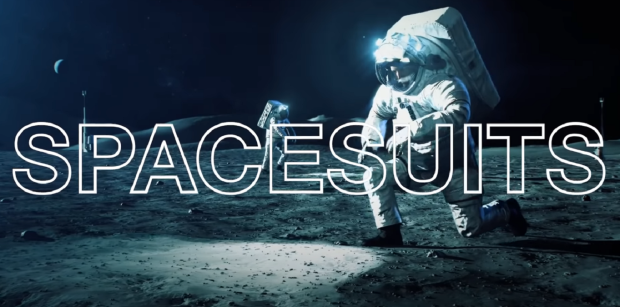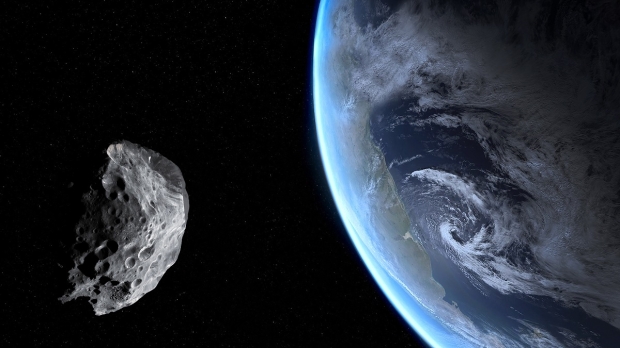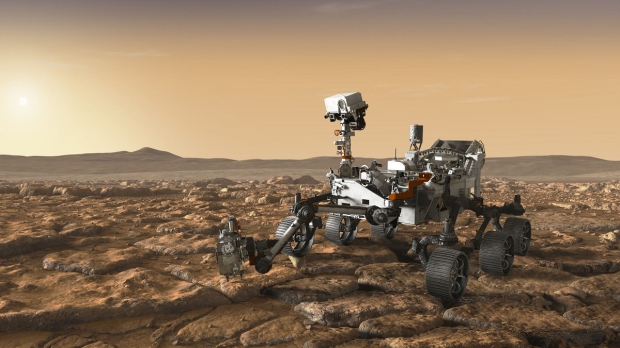Science, Space, Health & Robotics News - Page 258
NASA's next-gen spacesuits will prepare humanity for its giant leap
A new video has appeared on NASA's official YouTube channel that is essentially a trailer showcasing the space agency's next-generation spacesuits.
Through the video, NASA has announced that it will partner with the private space industry to construct brand new next-generation spacesuits that will be used for future astronauts in a plethora of missions. According to the video's description, the spacesuits will be "personalized" and will come with revolutionary upgrades in the forms of technology upgrades, better fits for astronauts, a larger range of sizes, better protection against the harsh environment of space.
Additionally, these spacesuits will enable the astronauts better mobility, allowing them to be "more nimble than ever before". The space agency says that these spacesuits will be used by astronauts aboard the International Space Station, future Artemis missions that will take humans back to the surface of the Moon, and will, most importantly, prepare NASA for "humanity's next giant leap - sending astronauts to Mars."
Continue reading: NASA's next-gen spacesuits will prepare humanity for its giant leap (full post)
World's largest underwater eruption birthed a new massive volcano
A study published in the journal Nature Geoscience has detailed the largest underwater eruption to ever occur gave birth to a skyscraper-sized volcano.
The study was published in Nature Geoscience back in late August, and details a "new" volcano that was discovered off the in the western Indian Ocean, off Madagascar. The underwater volcano emerged from the seafloor following a series of earthquakes that were detected in the region. The study looked at data from a 2014 underwater survey of the region and compared it to a 2019 survey and found that between those two dates, a volcano rose to a height of 8,465 feet below sea level.
The researchers collected geological data and found that this volcano draws magma from the deepest reservoirs ever recorded by scientists - about 34 miles underground. Nathalie Feuillet, a marine geoscientist at the Paris Institute of Earth Physics (IPGP), University of Paris, and lead author on the study, said, "The source of the magma, the reservoir, is very deep. This is the first time in volcanology that we can see such a deep reservoir at the base of the lithosphere."
Continue reading: World's largest underwater eruption birthed a new massive volcano (full post)
You may live inside a floating PS5-like house, says Sony in video
Last month Sony posted a video to its official YouTube channel that may have slipped under the radar when looking at its number of views.
The above video was posted on September 3 and showcased the finished product of collaborative work between Sony designers and science fiction writers. The goal of the collaboration was to come up with ideas of what life, working, senses and well-being would be like in Tokyo in 2050. The team's joint effort came up with a series of design prototypes, and one of them was the Floating Habitat that predicts humans will be living on the ocean in floating houses.
As stated in the above video, these floating habitats located in a bay are paired with solar panels located in the water. These solar panels generate electricity for the habitats and store them in autonomous energy tanks that detect when one is running low on power. They then connect to the habitat to replenish its supply. Additionally, multiple of these floating homes can be connected together to form a large structure that Sony says will reduce the impact of large waves.
Continue reading: You may live inside a floating PS5-like house, says Sony in video (full post)
Asteroid makes extremely close approach to Earth, NASA confirms
Reports indicate that an asteroid has made a relatively close approach to Earth, passing between our planet and the Moon.
According to Space.com, an asteroid named 2021 TG14 that has a diameter between 17.7 - 39.3 feet passed between the Earth and the Moon on Sunday, October 17. According to NASA's asteroid database, the space rock passed at a distance of 155,000 miles, and while that seems like quite a distance here on Earth, when talking in space terms, that is quite close to our small blue planet. For reference, the Moon is around 239,000 miles from Earth.
For those that don't know, an asteroid is an ancient piece of the early solar system when our cosmic neighborhood was just a collection of rock, ice, and debris before planets formed. For these reasons, astronomers see asteroids as valuable prospects for scientific research as they can contain information about the solar system's past and thus provide insightful information about its future. If you are interested in reading more about this story, check out this link here.
Continue reading: Asteroid makes extremely close approach to Earth, NASA confirms (full post)
This states largest volcano was shaken up, 33 earthquakes in 24 hours
A swarm of earthquakes has impacted a volcano in the United States. Officials have recorded 33 earthquakes in just 24 hours.
The US Geological Survey's (USGS) Cascades Volcano Observatory (CVO) has detected a new swarm of earthquakes impacting Oregon's Mount Hood volcano. According to officials, Mount Hood is classified as a "very high threat potential". However, the earthquakes it recently experienced are not abnormal and have not caused a change in the volcano alert level nor the aviation color code. The USGS wrote, "Several tens of small earthquakes have occurred near the summit of Mount Hood. This is not a volcanic event."
The USGS continued in its statement and said that the earthquakes began on October 17 and that the largest was an M2.5 at a depth of 1.8 - 3.1 miles below the surface. Additionally, none of the earthquakes were felt, and that swarms of earthquakes hitting the volcano are deemed "common" and "do not indicate a change in the volcanic hazard. Past swarms have lasted several days to a couple of weeks." If you are interested in reading more about the reported activity, check out this link here.
Continue reading: This states largest volcano was shaken up, 33 earthquakes in 24 hours (full post)
Monstrous cyclone storm incoming to US, officials drop warnings
AccuWeather has reported that a "beast of a bomb cyclone" is on its way towards the United States and that it may rival some of the hurricanes that have been seen throughout the Atlantic Ocean.
According to the report from AccuWeather, the monstrous cyclone storm will usher in dangerous amounts of rainfall up and down the West Coast of the United States. The report states that satellite imagery has shown that moisture has been transported all the way from India and other parts of southeast Asia across the northern Pacific and is now headed towards the West Coast of the US. AccuWeather Meteorologist Randy Adkins says that Tropical Storm Namtheun will combine with the non-tropical system in the Pacific on Wednesday.
Officials from the National Weather Service Weather Prediction Center have warned that the incoming storm will bring "heavy rain totals, worrisome for burn scars, and high elevation mountain snow". Adding, "The heaviest precipitation looks to come in two waves, one Thursday and another Sunday into Monday." Forecasters recommend keeping up to date on the movements of the storm if you are in the affected areas as with most storms, things can change quite rapidly. For more information on this story, check out this link here.
Continue reading: Monstrous cyclone storm incoming to US, officials drop warnings (full post)
Blast from the Sun hit Earth, causing beautiful auroras to appear
On October 9, the Sun blasted out a slew of charged particles directly at Earth. The result was a low-to-moderate geomagnetic storm taking place on our planet.
Earth has a protective shield against the fury of the Sun, and this protective shield is called our magnetosphere. When the Sun shoots out a coronal mass ejection (CME) - which is a significant release of plasma from the Sun - and it collides with our planet's magnetosphere, it can cause some considerable effects. Depending on how powerful the solar wind is from the blast, the CME can cause power outages, internet disruptions, satellite issues, and more.
Luckily, the event of October 9 didn't cause much damage at all since the blast was only relatively small in scale. However, the effects of the blast were seen across the globe in the form of auroras in the sky. Auroras happen when the charged particles from the solar wind get trapped in Earth's magnetic field and travel to the geomagnetic poles of the planet. The result is the stunning colors we see in the sky. The European Space Agency put together a video that is comprised of an image taken every 60 seconds throughout the duration of the solar storm. The video can be found above.
Continue reading: Blast from the Sun hit Earth, causing beautiful auroras to appear (full post)
NASA releases wild video of its rover speeding on the surface of Mars
NASA's Perseverance rover is designed for precision, and to achieve that, the rover must move incredibly slow - painfully slow.
NASA's Perseverance rover has a top speed on flat ground of a little less than 0.1 miles per hour. But, the space agency has released a new sped-up video of the rover traversing the Martian surface. The video is sped up by about 200 times, and in-between each frame of the video is about 30 seconds. "In total, the rover drove 574 feet (175 meters). The first 26 feet (8 meters) were based on commands sent up earlier by rover drivers, allowing Perseverance to build a 3D map of the terrain under and around it", wrote NASA.
The footage has been released onto the official Perseverance Twitter account and shows the rover taking the surface of the Red Planet head-on. Recently, NASA's Perseverance rover captured a panorama of the Martian surface that shows it in incredible detail. The image is a mosaic piece that is comprised of 84 separate images. If you are interested in checking out that image, click this link here.
Continue reading: NASA releases wild video of its rover speeding on the surface of Mars (full post)
If alien probes are close to Earth, this new telescope may find them
The idea of advanced aliens being out there somewhere in the cosmos has been an idea much speculated by everyday people as well as scientists.
There are people on both sides of the metaphorical fence that claim aliens are somewhere out there in the void and others who claim we are the first since we haven't detected them yet. Perhaps the problem isn't that they are real or not, perhaps, the problem is a limitation in our technology to detect them (if they are there). A new study has appeared on a preprint server that details the possibility of China's new radio telescope being capable of detecting alien probes within and beyond our solar system.
The paper explains through calculations that China's Five-hundred-meter Aperture Spherical Radio Telescope (FAST) could be able to detect alien probes within its radio spectral band that is a key feature of the telescope. The idea behind the telescope being able to detect alien probes is that these probes would emit some kind of radiation that China's new instrument could then detect. If you are interested in reading more about this story, check out this link here.
Continue reading: If alien probes are close to Earth, this new telescope may find them (full post)
Earth tipped on its side millions of years ago, did a 'cosmic yo-yo'
Researchers have analyzed limestone samples and have discovered that Earth tipped millions of years ago while dinosaurs were still walking around.
The new study has been published in Nature Communications and details an analysis of limestone samples from Italy that date back 65.5 to 100.5 million years ago during the Late Cretaceous period. The researchers were looking for evidence of a shift in Earth's magnetic record that would indicate True Polar Wander (TPW), which can cause whole planets and moons to tilt.
According to the study results, the researchers were able to identify evidence of a tilt occurring with bacteria fossils trapped within the limestone. These bacteria fossils provide evidence that during the aforementioned periods, the Earth's surface, which is made up of mantle and crust, tipped by 12 degrees around 84 million years ago and then corrected itself within about 5 million years.
Continue reading: Earth tipped on its side millions of years ago, did a 'cosmic yo-yo' (full post)











